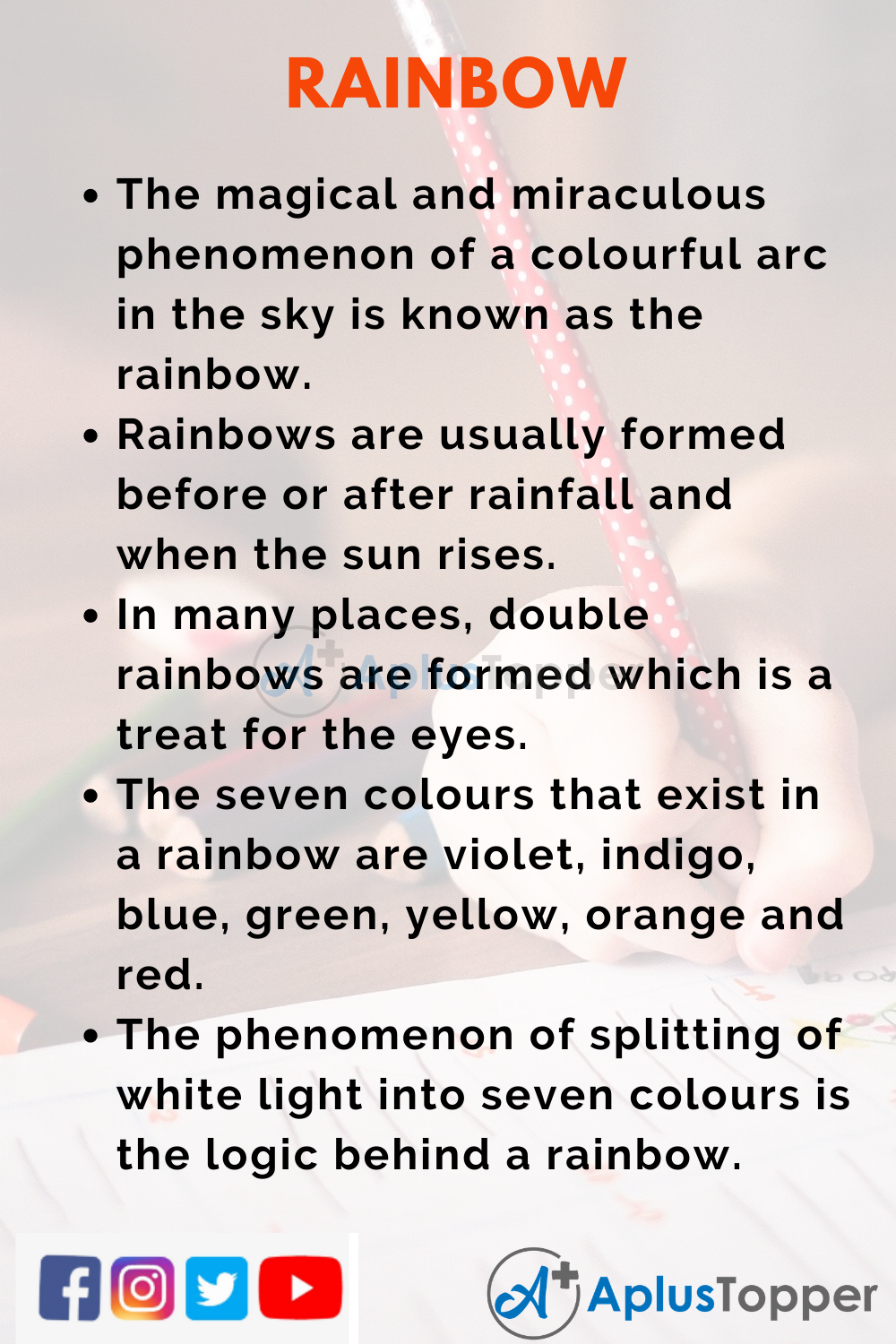10 Lines on Rainbow: When we were kids we all use to wonder the magical 7 colours that used to appear in the sky after rain. Most of us as kids didn’t know the scientific phenomenon of the rainbow but many us believed in some kind of miracle and magic that is happening in the sky. While it surely is a miracle, rainbows do have a scientific explanation.
In this particular article on 10 lines on Rainbow in English, we shall be answering certain questions such as what is a rainbow, how is a rainbow formed, what is the location of a rainbow, where does a rainbow end, where does a rainbow start, is rainbow magic, and many such questions will be answered below.
You can read more 10 Lines about articles, events, people, sports, technology many more.
Set 1 – 10 Lines on Rainbow for Kids
Set 1 is helpful for students of Classes 1, 2, 3, 4 and 5.
- The magical and miraculous phenomenon of a colourful arc in the sky is known as the rainbow.
- Rainbows are usually formed before or after rainfall and when the sun rises.
- In many places, double rainbows are formed which is a treat for the eyes.
- The seven colours that exist in a rainbow are violet, indigo, blue, green, yellow, orange and red.
- The phenomenon of splitting of white light into seven colours is the logic behind a rainbow.
- During or after the rain, water particles will be floating in the atmosphere which acts as a platform for the splitting of white light.
- Rainbows are usually seen on the opposite end of where the sun is located.
- In certain types of rainbows, not all colours can be seen distinctively and mainly yellow-green and red will be visible to the naked eye.
- The phenomenon of the rainbow can be studied even in laboratories with the artificial formation of the rainbow on a white screen.
- Ancient civilizations used to believe that appearance of the rainbow is a victory of good over evil.

Set 2 – 10 Lines on Rainbow for School Children
Set 2 is helpful for students of Classes 6, 7 and 8.
- Rainbow is an English word which is derived from the Latin word ‘Arcus Pluvius’.
- In the year 1994 on the 14th of March in England, the world’s longest rainbow was seen which lasted for more than 6 hours.
- A rainbow appears only when there are enough moist particles floating in the atmosphere and in the presence of sunshine.
- The altitude of the rainbow depends on the altitude of the sun and both of them are indirectly proportional.
- In many Civilizations, rainbows are considered to bring good to society and is a symbol of peace and harmony.
- Sometimes only red colour rainbows are formed in the sky and these are known as monochrome rainbows.
- Reflection, refraction and dispersion are the three phenomena that take place simultaneously to form a rainbow.
- Rainbows are an intangible phenomenon in the atmosphere which can only be seen but cannot be felt.
- VIBGYOR is the nickname given to all the colours that are seen in a rainbow which are violet, indigo, blue, green, yellow, orange and red.
- Rainbows are more easily formed near waterfalls and fountains because of increased water particles in the atmosphere in those areas.
Set 3 – 10 Lines on Rainbow for Higher Class Students
Set 3 is helpful for students of Classes 9, 10, 11, 12 and Competitive Exams.
- Rainbow is a meteorological process which involves reflection, refraction and dispersion of white light into water droplets.
- Alexander’s band is a phenomenon where Rainbow is seen over the dark sky, especially near waterfalls.
- Alexander’s band take place because the white light does not reach the human eye and is all absorbed into the water droplets lingering in the atmosphere.
- The rainbow in 1994 at Sheffield in England on March the 14th lasted from morning 9 a.m. to evening 3:00 p.m.
- Aristotle believed that rainbow consists of only three colours but people during the Renaissance period believe that there were more than four colours in the rainbow all of which was discarded after proper scientific discoveries.
- Isaac Newton, through his prism experiment, showed the world that the white colour splits into seven different colours and this is the logic behind the phenomenon of the rainbow.
- Rainbows are also produced at night and this is possible if the moonlight is strong enough to disperse through the water droplets.
- Rainbow, when looked on the ground, will be a half arc but if rainbows are looked on an aircraft, we can see the full circle of the rainbow.
- The white light that enters the water droplet bends and splits into seven different colours and the bending of these seven different colours depends on the wavelength of the light.
- Shortest wavelength starts from violet and the longest wavelength ends with the colour red and this is the reason why white light splits when it passes through dense water droplets forming a beautiful rainbow.

FAQ’s on 10 Lines on Rainbow
Question 1.
How are Rainbows is formed?
Answer:
Rainbows are formed when white light through the Sun or Moon disperses after it passes through water droplets in the atmosphere
Question 2.
What is the dispersion?
Answer:
Dispersion is a phenomenon in which white light splits into seven different colours after passing through a dense medium.
Question 3.
What is the full form of VIBGYOR?
Answer:
The full form of VIBGYOR is violet, Indigo, blue, green, yellow, orange and red
Question 4.
What is a monochrome rainbow?
Answer:
The monochrome rainbow is a type of rainbow in which only red colour arc is seen in the atmosphere.
